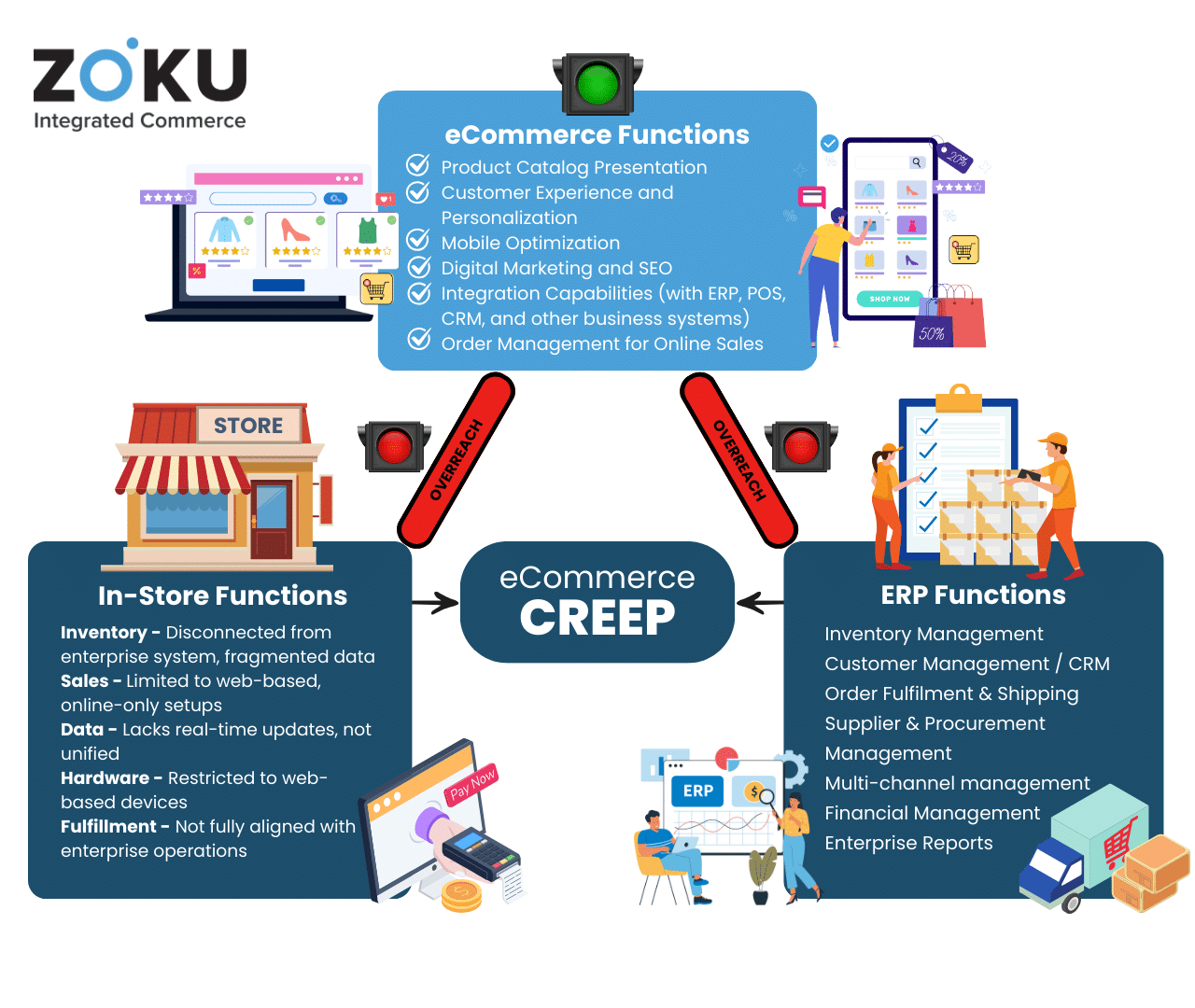POS integrations offered by eCommerce platforms seem like a no-brainer for businesses transitioning from online sales to brick and mortar. Solutions like Shopify and similar eCommerce platforms provide retailers with powerful tools to operate online stores, often offering multiple built-in point of sale (POS) systems as extensions. However, as businesses that start selling online, it soon becomes apparent – eCommerce platforms can’t also be ERP and POS at the same time.
What successful eCommerce retailers often recognize is the need for a single, unified data hub that eliminates information silos and ensures accuracy. While eCommerce platforms with integrated POS can handle basic physical sales needs for online-first businesses, they aren’t designed to handle the complexities of a multi-store, multi-channel operation.
In this article, we’ll explore why these systems struggle to keep up with larger operations and why unified commerce—particularly those anchored by NetSuite—offers the best solution for growing retailers.

For example, when an item is purchased, a unified commerce system automatically updates inventory counts in real-time in a central, underlying database. This database is linked with accounting & procurement (for automatic re-ordering) and an ecommerce platform. Errors and discrepancies across physical and digital stores are drastically reduced. This level of synchronization is difficult to achieve with eCommerce platforms that only offer basic POS functionalities.
Why eCommerce Systems with POS Integration Work… Until They Don’t
Platforms like Shopify, designed for eCommerce-first businesses, provide POS solutions for companies with simple or temporary POS needs. Generally, a platform like Shopify lets you connect a range of different POS solutions, track both online and in-store transactions in a single ecosystem, which is great for small-scale operations.
These platforms recognize the need for omnichannel functionality, and naturally must rely on API and custom-built add-ons to keep up. At Zoku, we call the process of online sales platforms adding omnichannel style features ‘Omnichannel Creep.’ The problem with omnichannel creep systems arise when retailers try to scale beyond a few outlets. As noted in Gartner’s Market Guide for Unified Commerce Platforms, retailers with multi-location stores face operational challenges when they attempt to piece together systems originally designed for eCommerce-only environments. While these platforms may offer POS functionality, they lack the robust infrastructure required to manage real-time inventory, multi-store operations, and complex customer journeys across both digital and physical touchpoints.
The ‘Frankenstein’ Problem
For growing retailers, the common approach is to add middleware and API integrations in an effort to bridge the gaps between systems. On paper, this seems like an efficient way to manage multiple locations while maintaining eCommerce functionalities. But in reality, this approach often creates more problems than it solves. Gartner emphasizes that adding layers of integration increases complexity and can lead to inefficiencies(Gartner Reprint).
Here are the main challenges businesses face when using patchwork systems:
- Data Discrepancies Across Locations: eCommerce platforms with basic POS integrations often struggle to synchronize inventory data in real time across multiple locations. This results in inconsistent stock levels, where one store shows products as available while another shows them as sold out.
- Limited Visibility for Decision Making: Retailers need comprehensive, real-time data from across all stores and channels. When systems are not fully integrated, this visibility is compromised, making it difficult to manage inventory, predict demand, or respond quickly to market changes.
- Manual Workarounds: As businesses grow, so do the complexities of managing multiple systems. Staff are often forced to rely on manual workarounds to ensure operations run smoothly, which adds to labor costs and increases the risk of human error.
The Customization Problem: Tablet-Based POS vs. Zoku
One of the biggest limitations of tablet-based POS systems, like Shopify’s, is their lack of customization. These systems are often described as a “one-size-fits-all” solution optimized for businesses that are primarily focused on online sales. While they provide essential POS functions, they struggle to meet the more complex requirements of larger retailers.
Zoku, on the other hand, offers a hardware-agnostic POS solution that works across tablets, mobile devices, PCs, and traditional POS hardware. This flexibility allows businesses to customize their setup based on their specific needs, making it ideal for multi-outlet retailers with more complex operations. Zoku’s platform offers more robust features that are designed for businesses needing real-time inventory management, multi-location support, and seamless customer experiences across all channels.
Truly Unified Commerce
Unlike eCommerce platforms with bolt-on POS solutions, unified commerce offers a fully integrated system that spans both digital and physical touchpoints. Rather than trying to make disconnected systems communicate, unified commerce platforms bring everything—POS, inventory, CRM, accounting, ERP and eCommerce—into a single, unified infrastructure. This is especially valuable for multi-outlet retailers who need seamless integration to manage inventory, sales, and customer data across all channels in real time.
Gartner’s research highlights that unified commerce platforms anchored by POS systems offer real-time synchronization of inventory and customer data across all locations and sales channels. This means that whether a customer is shopping online, buying in-store, or making a return, the retailer has a complete, up-to-date view of their inventory and customer interactions.
NetSuite and Zoku: Unified Commerce in Action
One of the leading solutions for unified commerce is NetSuite, a cloud-based ERP system that Zoku integrates to power its unified commerce platform. NetSuite’s robust system allows retailers to manage their entire business—inventory, sales, finance, and customer data—from one centralized location.
Zoku’s integration with NetSuite enables retailers to go beyond the limitations of eCommerce-first POS systems by providing:
- Real-Time Inventory Management: Every store and warehouse is connected in real time, so stock levels are automatically updated whenever a sale is made, regardless of where it happens.
- Customer-Centric Shopping Experiences: With a unified view of the customer, retailers can offer personalized experiences, whether the customer is shopping online or in-store.
- Simplified Operations Across All Channels: By integrating all aspects of retail operations, NetSuite and Zoku reduce the need for manual processes and eliminate the risk of data silos.
Gartner emphasizes the importance of platforms like NetSuite in creating composed commerce ecosystems, which allow businesses to streamline operations across multiple touchpoints(Gartner Reprint).
Unified Commerce vs. Patchwork Systems: Real-Life Implications
Imagine a retailer operating 15 stores across the UK. The retailer wants to ensure that both online and in-store inventory is synced, allowing customers to shop seamlessly between channels. Using an eCommerce system with a basic POS integration, the retailer would be managing the entire business from the online store, not from the enterprise itself. They would need to build or buy out-of-the-box integrations with other software, such as accountancy. So, retailers will face significant challenges in managing stock levels and customer data across multiple stores. They’d likely rely on manual workarounds and experience delays in real-time inventory updates. And, when you’ve got multiple locations, this can soon become seriously time-consuming and cause significant operational issues.
By switching to a unified commerce platform powered by NetSuite, inventory is updated in real-time with each purchase, preventing stock discrepancies and ensuring accurate order fulfillment. ERP automation also streamlines repetitive tasks like reordering, shipping calculations, and accounting, reducing the risk of human error. This allows businesses to handle increased demand effortlessly and provide customers with real-time product and inventory updates online, 24/7.
This kind of real-time synchronization is critical for growing retailers, and it’s something that eCommerce platforms with bolt-on POS systems simply can’t deliver at scale.
Unified Commerce Is the Future for Multi-Outlet Retailers
Omnichannel creep systems (eCommerce platforms with built-in POS systems), serve a valuable purpose for small and medium businesses with simple sales needs. Particularly those who have no plans to scale. But as retailers expand and open multiple locations, these systems start to show their limitations. Trying to patch together systems to accommodate growth often leads to inefficiencies, increased labor costs, and operational bottlenecks.
For retailers looking to scale effectively, unified commerce platforms—especially those anchored by NetSuite, like Zoku—offer the best solution. With real-time data synchronization, seamless customer experiences, and streamlined operations, unified commerce platforms provide the infrastructure needed to thrive in today’s competitive retail environment.

